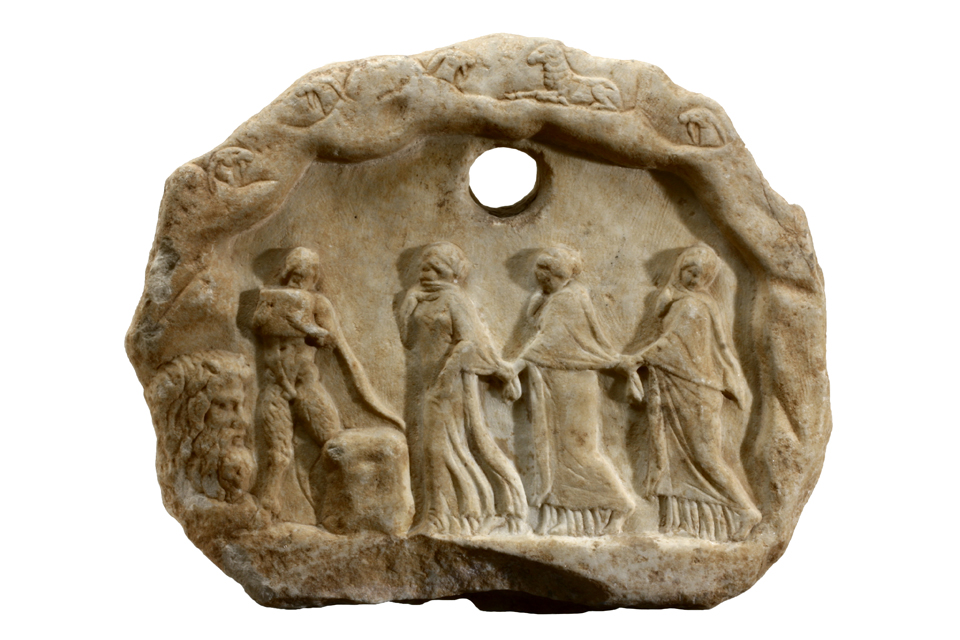Exhibit of the month
Beautiful dances (The Odyssey, 12,318)
Votive relief depicting dance scene
Sculpture Collection, inv. no. Γ1445
Provenance: It was found at the region of Eleusis in 1877.
Date: End of 4th c. BC
Dimensions: H. 0,29 m., W. 0,35 m.
Display location: Room 25.
Votive relief in the shape of a cave, dedicated to the Nymphs. Ιt probably comes from the Cave of Pan in Eleusis, Attica. The hole in the middle served for its suspension in the sanctuary. A ram and four goats are depicted on the mouth of the cave. Three Nymphs dance gracefully with rhythmical moves around an altar, holding each other’s clothes, their heads in a different pose. Their dance is performed with great elegance and liveliness. Pan, the goat-footed god, himself a perfect dancer, as poet Pindar calls him, accompanies them musically with the syringe.
On the left, the personification of river Acheloos indicates symbolically the landscape of a riverside sanctuary. The pleasant and calm bucolic scene conveys the atmosphere of an outdoor natural environment, exactly as people imagined the Nymphs dancing in circle outside their caves on mount Helicon, in Phocis, in Attica and throughout Greece.
The mythical dances of the gods and heroes served as the model for the dances of people. Worshipers, in festivals and ceremonies, imagined that their anthropomorphic gods danced with them. Charites, Horai, Nereids, Nymphs and other youthful female deities are often depicted moving rhythmically, usually in triads. The joy of dance suited the ancient Greek religion and formed one of its key elements. The religious dance – rhythmic, repetitive and structured movement, strict and calm – was part of the ceremonial ritual on major festivals, such as the Thesmophoria and the Hyacinthia. In this way, members of the community had the opportunity to communicate, compete in public, be distinguished, have fun and address their gods in a pleasant way, in front of an audience. Everyone participated in the event, either as dancers or as spectators.
Literary sources refer to some types of religious dances, such as the Partheneia in the Doric cities, the Antheia in Argos, the obscene Kordax in Elis, orgy dances in the context of Dionysian worship and dances in honor of Apollo in Delos and Delphi. The imitation, the pleasant contact with the divinity, the team spirit and the playful dimension of this form of worship made dancing a popular activity of the Greeks, often represented in ancient art.
Dr Ariadne Klonizaki
BIBLIOGRAPHY
Isler, H.P., Lexicon Iconographicum Mythologiae Classicae (LIMC ) 1.2., «Acheloos», 1970, no.178, 23.
Kaltsas, N. Εθνικό Αρχαιολογικό Μουσείο, Τα Γλυπτά, Athens, 2002, 219, cat. No. 455, with relevant bibliography.
Travlos, Ι., Αρχαιολογικό Δελτίο 16, 1960, Β΄ Chronicles, 52-55.
GENERAL BIBLIOGRAPHY
Chaniotis, A., «Festivals and Contests in the Greek World», ThesCRA VII, 2011, 1-43.
Larson, Greek Nymphs, Oxford, 2001.
Lonsdale, S., Dance and Ritual Play in Greek Religion, Baltimore & London, 1993.
Shapiro, A., «Dance», Thesaurus Cultus et Rituum Antiquorum (ThesCRA) II, 2004, 299-343.
Lanara-Vogiatzi, Ch., «About dances», GIFTS OF THE MUSES Echoes of Music and Dance from Ancient Greece, Exhibition Catalogue, Megaron, The Athens Concert Hall, 1/7-15/9/2004, Hellenic Ministry of Culture, Athens 2004, 87-91.


